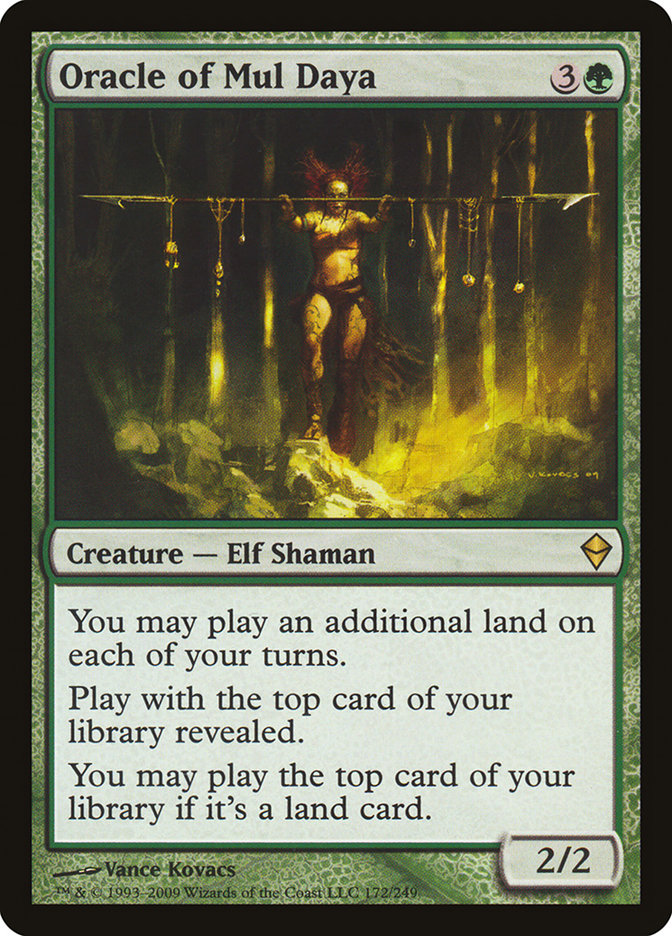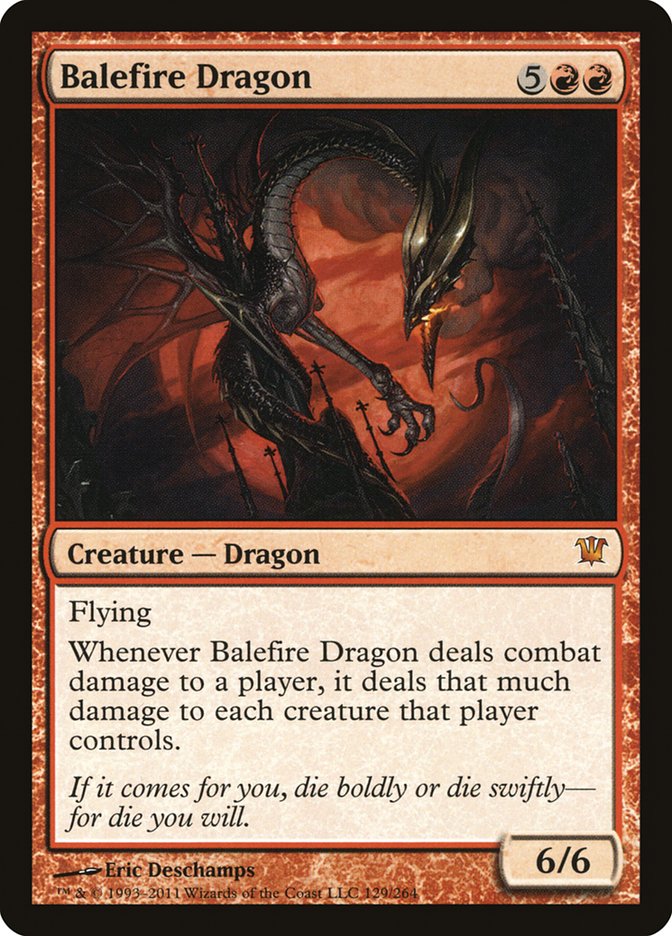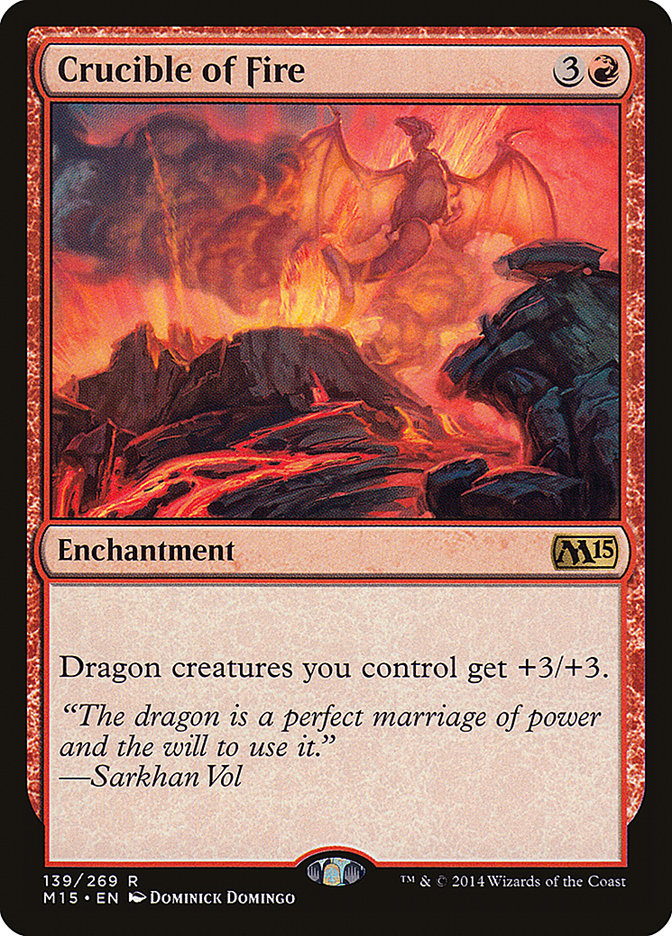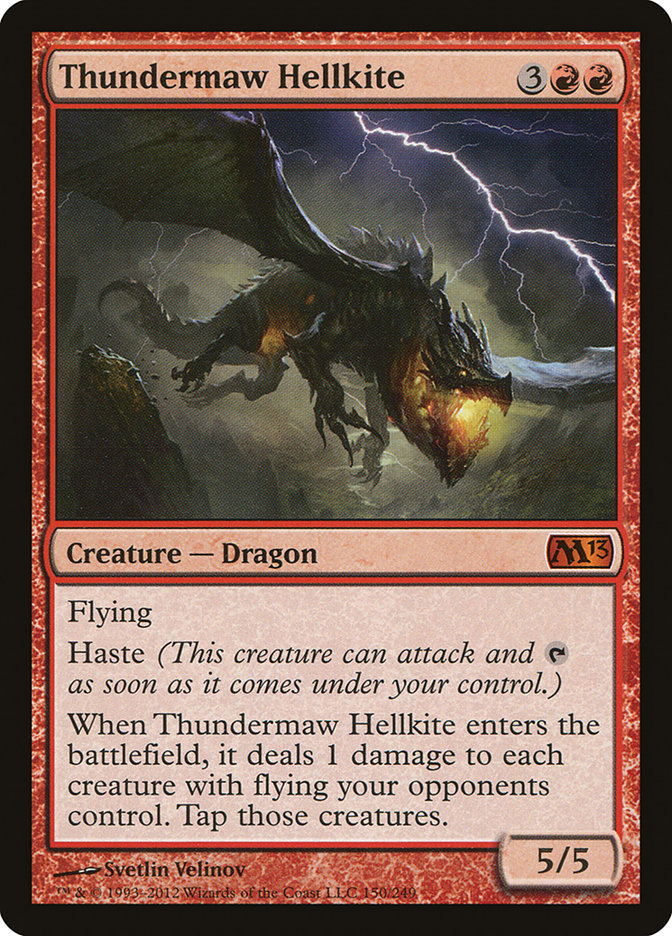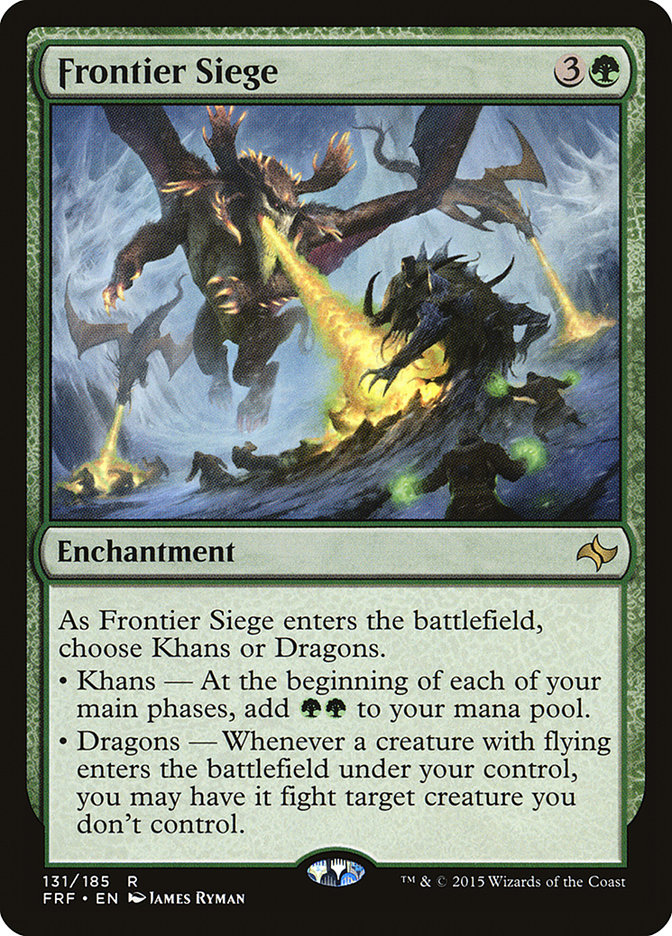I get the occasional email asking for some advice on building a deck or thoughts on particular cards. I’m not much of a deck doctor, leaving that task to folks like Sean McKeown and friends, who do a much better job than I might. I’ll almost always respond to every single email I get asking for help, but I don’t think I’ve ever translated that into print. Perhaps it was my mood (more on that below), but for some reason, a request I got from Nick Weatherbee this past week struck a chord. It sounded like fun to offer Nick some ideas, which is what we’ll do this week. Here’s the relevant part of his email:
I read your articles on StarCityGames.com and I have been a fan for a while. My favorite articles include your play-by-plays on your Commander games as well as your Draft articles for your local group. I am trying to make a Dragon Commander deck with Atarka, World Render as the commander. I have been in a quandary about which direction to take and what stuff to include. I was wondering if you could provide some assistance. I want the deck to hit hard and fast but not just be a Voltron build. I want to keep it Dragon tribal but I am still willing to use things to cut down the dragons casting costs.
I was thinking of doing Karrthus, Tyrant of Jund first, but his ability seems a little weak and could be a killer for me if an opponent clones him.
The reason that I chose this Atarka is because of the combat ability. It makes all of my Dragons hit harder. I usually play games with three to four people and I want to be the aggressor the whole time and make the table react to me. Any advice that you can provide is greatly appreciated.
V/R,
Nick Weatherbee
Nick also offered up that card cost doesn’t matter. Although I’m not afraid to throw a few dollars at a deck, my experience is that it isn’t the business end which drives up the cost of your deck but two factors: foiling and lands. Regular readers will know that I’m addicted to foiling out decks. I now have 39 of them assembled, nearly all of them as foiled-out as possible. Addictions will always make you spend your hard-earned cash.
Then we have land. I wouldn’t consider anything as a must-have, but the best of them (especially if they’re available in foil) can be quite expensive. Imagine full-on dual lands for each of 39 decks (okay, 33, since there are five mono-color and one colorless). The good news is that “good” lands, which help you smooth out your manabases, are getting cheaper and more available. The Return to Ravnica versions of shocklands, even in foil, are quite affordable. I have it on good authority that R&D is doing their best to make reasonable mana fixing even more available in future sets. The point is that, sure, you can treat yourself to the occasional Underground Sea, but you don’t have to in order to make your Commander deck fire on all cylinders. There are plenty of good options available.
I might point to the Odyssey cycle of filter lands, Darkwater Catacombs, Mossfire Valley, Shadowblood Ridge, Skycloud Expanse, and Sungrass Prairie, as budget-conscious options. If you’re already playing black, Tainted Field, Tainted Isle, Tainted Peak, and Tainted Wood make inexpensive additions.
But enough about lands. Let’s talk about how we can help Nick with Atarka, World Render.
The Requirements
We’ll work off of the two things which Nick has stated he’d like and the one he said he didn’t want:
- Dragon Tribal
- Be the aggressor/set the pace of action
- Not Voltron
That all seems reasonably straightforward. In fact, the problem in assembling Atarka is in getting trapped into too narrow of a build. It would be easy to cram a deck with a bunch of big, fat Dragons, but we need a little more style to it. Although I love Karrthus, Tyrant of Jund, I agree with Nick that we need to be careful, because one Clone of your commander can ruin your day. Not having black cuts out some choices, but we still have lots to work with.
There are 95 Dragons in the R/G color identity, plus eight more that are Dragons by virtue of the fact that they have the changeling ability. Among the latter, there are some saucy choices like Chameleon Colossus, Changeling Titan, and Taurean Mauler. We have more than enough creatures to choose from, which means we’ll need to do quite some narrowing.
But even a tribal deck isn’t all about just the creatures of that type; it’s about the support as well. We’ll need to figure out just what we mean by being the aggressor. To me, it’s not just about having large creatures, but about either forcing other players to deal with them or rendering them unable to do so.
I’m not going to build the exact 99 for Nick, but I’m going to suggest several elements and then offer some ideas within those elements.
The first of the three is ramp. In order to cast big things, Nick will need to use the power of green to get more mana than his opponents.
The second element is the Dragons themselves. Which are the cost-friendly and appropriately scary ones? There are some outstanding seven- and eight-mana Dragons, but you can’t exactly pack your deck with twenty of them and still have a chance to reliably cast them; a decent mana curve is in order (although I think it’s going to be tough to be particularly tight with it).
The third element is the extra aggression. This is the most fluid spot, one I’ll offer multiple thoughts on.
Ramp
In the context of this deck, ramp is both getting additional lands onto the battlefield as well as making those Dragons cheaper or easier to cast or put onto the battlefield. I like a package of six to eight spells or creatures to make sure things get running. Rampant Growth, Cultivate, Kodama’s Reach, Skyshroud Claim, and Ranger’s Path are popular choices in the colors.
I’d avoid high-mana-cost ramp spells like Boundless Realms, because by the time you’re at seven mana, you want to be summoning monsters. In this deck, which is likely to have quite a few high-casting-cost creatures in it, Recross the Paths seems like a fantastic idea, since you have a reasonable chance of winning the clash. I play it in a few decks and it is very good about paying dividends. There are also some creatures which will do the work, including Farhaven Elf, Wood Elves, Oracle of Mul Daya, Courser of Kruphix, and of course Solemn Simulacrum.
Permanents which help produce additional mana is an avenue worth exploring. Mana Flare, Heartbeat of Spring, and Dictate of Karametra are thoughts, but helping out opponents isn’t generally something you want to consider. If you’re going that way, Overabundance is a great choice, since there’s some pain associated with it as well. Mana Reflection is a great choice; the best is Zendikar Resurgent, since it both gives you extra mana and draws cards when you do what you love doing—namely, casting creature spells.
There are also things which reduce the cost of casting Dragons. Dragonlord’s Servant and Dragonspeaker Shaman reduce the cost by one and two generic mana, respectively. Urza’s Incubator, obviously choosing Dragon, also reduces their cost by two generic.
Then you have permanents which let you put creatures directly onto the battlefield, such as Belbe’s Portal, Quicksilver Amulet, and Elvish Piper. Spells which put creatures onto the battlefield include Selvala’s Stampede, Genesis Wave (which puts out more than just creatures), and the grandad of them all, Tooth and Nail. Lurking Predators is also a choice here, but that’s a given for nearly any green deck with creatures. You might even consider getting a little crazy with The Great Aurora, but I imagine this build will be more about a few giant things instead of a bunch of small ones. Along those same lines is Guild Feud, which will likely net you a far larger creature than your opponent. Since they choose first, you get to have extra information before making your choice.
Creatures
Because there are so many choices, the creature selection will be mostly a matter of taste. Atarka giving your Dragons double strike means we want to concentrate on those that do something when they do combat damage.
If one hit from Balefire Dragon doesn’t wipe out your opponents’ teams, two certainly will. Mordant Dragon does the same to a single creature. Steel Hellkite triggering twice gives you the opportunity to take out permanents of two different mana costs (and don’t forget tokens have a converted mana cost of zero). Dragon Mage might be interesting if you’re trying to mill out everyone, but filling up other players’ hands can always be a tricky proposition.
If you’re creating Dragons in multiple ways, such as when Utvara Hellkite attacks or you have Dragonmaster Outcast and enough land, Scourge of Valkas will get out of hand rather swiftly. If you want it to get the most insane, add Dragon Broodmother. Most of your Dragons end up in the five- to eight-mana slots, so you’re not really going to have a curve; you’ll be casting support spells early and then getting into the big stuff after. Dragons don’t need an early-game because they have such a powerful late one.
Extra Aggression
I look at being additionally aggressive from three different perspectives—additional damage, additional combat steps, and getting opposing creatures out of the way. Additional damage is relatively simple, referring to abilities like Moonveil Dragon or Adaptive Automaton, which make your creatures larger. With double strike, every extra point of power results in two additional damage.
There is the well-named Crucible of Fire, which gives all your Dragons +3/+3. You can also go with the damage doublers like Furnace of Rath, Dictate of the Twin Gods, and Gratuitous Violence, the last being safer for you since it only applies to your creatures. If you’re doubling damage, you might as well add Dragon Tempest, which for the low cost of 1R both gives haste to your fliers and deals damage based on the number of Dragons you control. Note that with Dragon Tempest, the Dragon itself deals the damage (just like with Warstorm Surge), meaning Gratuitous Violence applies.
Scourge of the Throne and Hellkite Charger are creatures that give you additional combat steps, which just multiplies your double-striking damage. Aggravated Assault and Savage Beating both do the work you’re looking for them to perform and have names which apply to what you’re doing. If you’re of the infinite combo mindset, combine Sword of Feast and Famine or Bear Umbra with Hellkite Charger.
To me, the techy solution is to get creatures out of the way. There’s the less safe way of making everyone else attack all the time, such as with Fumiko the Lowblood, Avatar of Slaughter, and Warmonger Hellkite, the latter having the advantage of being a Dragon. If you’re going with that angle, make sure you play a few Fog effects. I’m partial to Arachnogenesis (which might be a little off-theme) and the two Fogs which take creatures out of subsequent combats, Tangle and Spore Cloud. You might think about using Spore Cloud in a combat that you’re not involved in, since it locks down both attackers and blockers.
Thundermaw Hellkite will take the relevant creatures (fliers) out of commission when it enters the battlefield. Forgestoker Dragon is sweet at both preventing blockers and messing with combat math. Frontier Siege (choosing Dragons, obviously) can take blockers out of the way by creating fights—and note that it’s optional, so you choose to not do it if you don’t have a favorable outcome.
I’m even a little more partial to Threaten effects (such as Act of Aggression or Act of Treason) to get blockers out of the way while creating additional attackers. Molten Primordial will give you a creature from each opponent. Might Makes Right gives you a repeatable Threaten every combat, although since it’s conditional, the six mana to cast it might be a little high. Sarkhan Vol can either give your whole team a boost or Threaten a creature. If he’s around long enough for you to activate his -6 ability, it’ll give you twenty power worth of Dragons (important if you’re playing Dragon Tempest or Warstorm Surge).
Insurrection is the mack daddy of all Threaten effects and is usually a game-ender. In case that it’s not, you can always run sacrifice outlets as creature removal. I’m fond of those which don’t cost any mana, such as a card-drawer like Greater Good, a damage-dealer like Goblin Bombardment, or a mana-producer like Phyrexian Arena or Ashnod’s Altar. If you’re running those sacrifice outlets (which keeps you have from having to exile the creatures) or you just want to think about going all-in, Zirilian of the Claw lets you search up Dragons and put them onto the battlefield for far less than their normal mana costs.
When it comes down to it, there doesn’t seem to be a definitive build of Atarka, World Render. The end result will no doubt be battling with a horde of large flying lizards, but how you get there will be up to personal tastes.
Rules Question of the Week
André Tepedino asked me if Akroma, Angel of Fury can still be countered if cast from the Command Zone as a face down creature. The answer lies in the rules for Morph (702.36):
Morph is a static ability that functions in any zone from which you could play the card it’s on, and the morph effect works any time the card is face down. “Morph [cost]” means “You may cast this card as a 2/2 face-down creature with no text, no name, no subtypes, and no mana cost by paying {3} rather than paying its mana cost.”
Note that the rules mention the spell has no name.
The ability on Akroma, Angel of Fury specifically references the name in the part that says it can’t be countered. Ergo, face down Akroma (whether from the Command Zone or not) can indeed be countered, because it’s not at that point called Akroma, Angel of Fury. Great question, André!
A Personal Note
As some of you may know from my posts on social media, I was diagnosed with throat cancer just before Thanksgiving. The positive news is that because I’ve never been a smoker, doctors predict a decent chance of a cure. Nonetheless, I’m in for quite a battle and it’s going to get extremely rocky.
One of the things which will be therapeutic during treatment and recovery is continuing to do the things I love. One of those things is writing about the best format ever. I’m surrounded by an incredible support network, to include my remarkable wife, and I’m lucky enough to live near one of the country’s best treatment facilities, all which helps keep my attitude positive. Likewise, my extended family of Magic friends, to include the SCG community, has been amazing and will continue to help me through what will no doubt be a difficult time. I thank you all in advance for the well-wishes and support.
This week’s Deck Without Comment is Karrthus, Who Rains Fire From The Sky, which I hope might give Nick some additional ideas (like reminding him to play Cavern of Souls).
Creatures (27)
- 1 Dragonspeaker Shaman
- 1 Sakura-Tribe Elder
- 1 Solemn Simulacrum
- 1 Ryusei, the Falling Star
- 1 Bladewing the Risen
- 1 Bogardan Hellkite
- 1 Scourge of Kher Ridges
- 1 Flameblast Dragon
- 1 Dragon Broodmother
- 1 Dragonmaster Outcast
- 1 Steel Hellkite
- 1 Hoard-Smelter Dragon
- 1 Balefire Dragon
- 1 Thundermaw Hellkite
- 1 Utvara Hellkite
- 1 Hellkite Tyrant
- 1 Scourge of Valkas
- 1 Stormbreath Dragon
- 1 Siege Dragon
- 1 Warmonger Hellkite
- 1 Kolaghan, the Storm's Fury
- 1 Shockmaw Dragon
- 1 Destructor Dragon
- 1 Atarka, World Render
- 1 Dragonlord Atarka
- 1 Dragonlord Kolaghan
- 1 Savage Ventmaw
Planeswalkers (2)
Lands (37)
- 1 Strip Mine
- 6 Forest
- 1 Volrath's Stronghold
- 1 Swamp
- 4 Mountain
- 1 Taiga
- 1 Bayou
- 1 Badlands
- 1 Temple of the False God
- 1 Maze of Ith
- 1 Golgari Rot Farm
- 1 Overgrown Tomb
- 1 Gruul Turf
- 1 Skarrg, the Rage Pits
- 1 Stomping Ground
- 1 Blood Crypt
- 1 Rakdos Carnarium
- 1 Mosswort Bridge
- 1 Savage Lands
- 1 Dragonskull Summit
- 1 Bojuka Bog
- 1 Command Tower
- 1 Woodland Cemetery
- 1 Kessig Wolf Run
- 1 Cavern of Souls
- 1 Temple of Abandon
- 1 Opal Palace
- 1 Crucible of the Spirit Dragon
- 1 Haven of the Spirit Dragon
Spells (33)
- 1 Quicksilver Amulet
- 1 Sol Ring
- 1 Earthquake
- 1 Rampant Growth
- 1 Darksteel Ingot
- 1 Decimate
- 1 Patriarch's Bidding
- 1 Decree of Pain
- 1 Fault Line
- 1 Gilded Lotus
- 1 Scrabbling Claws
- 1 Dragon Fangs
- 1 Dragon Breath
- 1 Insurrection
- 1 Explosive Vegetation
- 1 Greater Good
- 1 Pernicious Deed
- 1 Violent Ultimatum
- 1 Comet Storm
- 1 Momentous Fall
- 1 Cultivate
- 1 Genesis Wave
- 1 Into the Core
- 1 Beast Within
- 1 Warstorm Surge
- 1 Guild Feud
- 1 Might Makes Right
- 1 See the Unwritten
- 1 Crux of Fate
- 1 Frontier Siege
- 1 Dragon Tempest
- 1 Flameshadow Conjuring
- 1 Nissa's Revelation

Check out our comprehensive Deck List Database for lists of all my decks:
SIGNATURE DECKS
Purple Hippos and Maro Sorcerers; Kresh Into the Red Zone; Halloween with Karador; Dreaming of Intet; You Did This to Yourself;
THE CHROMATIC PROJECT
Mono-Color
Heliod, God of Enchantments; Thassa, God of Merfolk; Erebos and the Halls Of The Dead; Forge of Purphoros; Nylea of the Woodland Realm; Karn, Beatdown Golem
Guilds
Lavinia Blinks; Obzedat, Ghost Killer; Aurelia Goes to War; Trostani and Her Angels; Lazav, Shapeshifting Mastermind; Zegana and a Dice Bag; Rakdos Reimagined; Glissa, Glissa; Ruric Thar and His Beastly Fight Club; You Take the Crown, I’ll Take Leovold; Gisa and Geralf Together Forever;
Shards and Wedges
Adun’s Toolbox; Animar’s Swarm; Karrthus, Who Rains Fire From The Sky; Demons of Kaalia; Merieke’s Esper Dragons; Nath of the Value Leaf; Rith’s Tokens; The Mill-Meoplasm; The Altar of Thraximundar; The Threat of Yasova; Zombies of Tresserhorn
Five-Color
THE DO-OVER PROJECT
Animar Do-Over; Karador Do-Over; Karador Version 3; Karrthus Do-Over; Mimeoplasm Do-Over; Phelddagrif Do-Over; Rith Do-Over; Ruhan Do-Over
If you’d like to follow the adventures of my Monday Night RPG group (in a campaign that’s been alive since 1987) which is just beginning the saga The Lost Cities of Nevinor, ask for an invitation to the Facebook group “Sheldon Menery’s Monday Night Gamers.”






